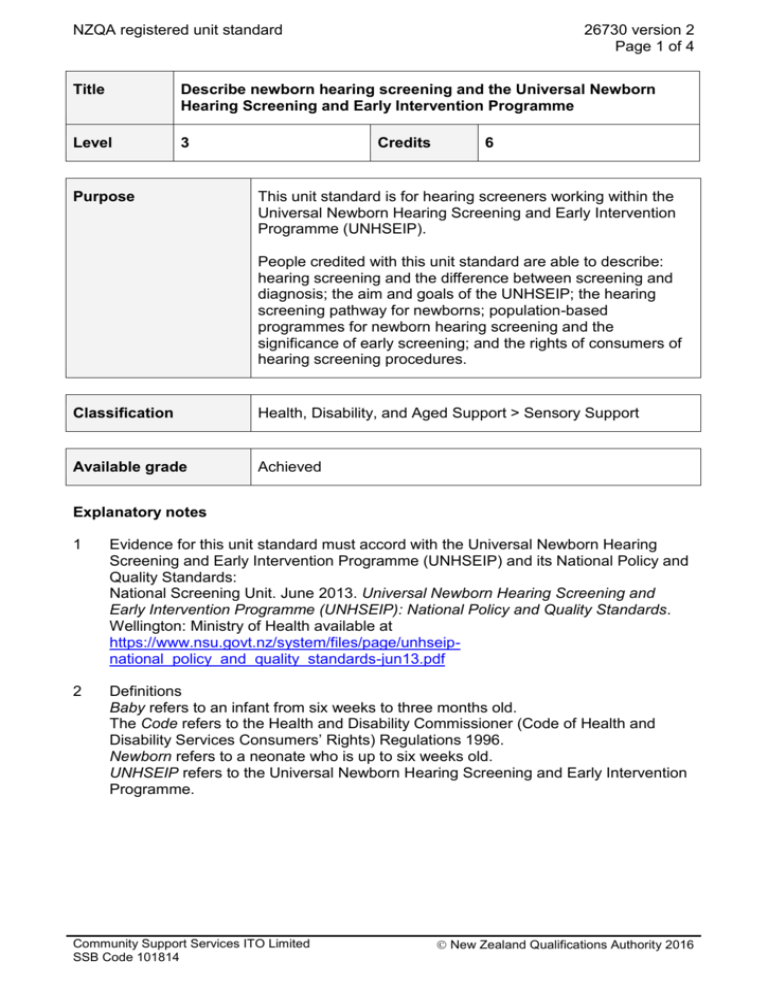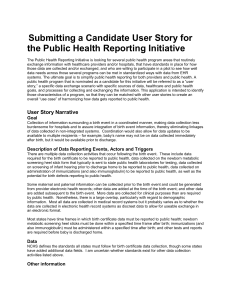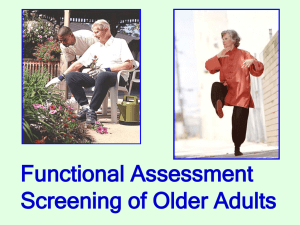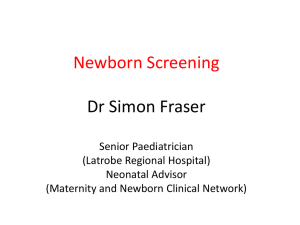26730 Describe newborn hearing screening and the
advertisement

NZQA registered unit standard 26730 version 2 Page 1 of 4 Title Describe newborn hearing screening and the Universal Newborn Hearing Screening and Early Intervention Programme Level 3 Purpose Credits 6 This unit standard is for hearing screeners working within the Universal Newborn Hearing Screening and Early Intervention Programme (UNHSEIP). People credited with this unit standard are able to describe: hearing screening and the difference between screening and diagnosis; the aim and goals of the UNHSEIP; the hearing screening pathway for newborns; population-based programmes for newborn hearing screening and the significance of early screening; and the rights of consumers of hearing screening procedures. Classification Health, Disability, and Aged Support > Sensory Support Available grade Achieved Explanatory notes 1 Evidence for this unit standard must accord with the Universal Newborn Hearing Screening and Early Intervention Programme (UNHSEIP) and its National Policy and Quality Standards: National Screening Unit. June 2013. Universal Newborn Hearing Screening and Early Intervention Programme (UNHSEIP): National Policy and Quality Standards. Wellington: Ministry of Health available at https://www.nsu.govt.nz/system/files/page/unhseipnational_policy_and_quality_standards-jun13.pdf 2 Definitions Baby refers to an infant from six weeks to three months old. The Code refers to the Health and Disability Commissioner (Code of Health and Disability Services Consumers’ Rights) Regulations 1996. Newborn refers to a neonate who is up to six weeks old. UNHSEIP refers to the Universal Newborn Hearing Screening and Early Intervention Programme. Community Support Services ITO Limited SSB Code 101814 New Zealand Qualifications Authority 2016 NZQA registered unit standard 26730 version 2 Page 2 of 4 Outcomes and evidence requirements Outcome 1 Describe hearing screening and the difference between screening and diagnosis. Evidence requirements 1.1 Hearing screening is described in accordance with the National Policy and Quality Standards. 1.2 The difference between hearing screening and diagnosis is described in terms of purpose, expected outcomes, and limitations. Outcome 2 Describe the aim and goals of the UNHSEIP. Evidence requirements 2.1 The aim is described in terms of impacts on newborns born with hearing loss. Range 2.2 evidence is required for two parts of the aim. The goals are described in terms of hearing screening, diagnosis, and intervention. Outcome 3 Describe the hearing screening pathway for newborns. Evidence requirements 3.1 The hearing screening pathway is described in terms of its sequence of events and the quality requirements of the National Policy and Quality Standards. 3.2 Opportunistic hearing screening and nationally organised screening programmes are described in terms of their differences. 3.3 The benefits and potential harm of a nationally organised hearing screening programme are described in terms of health outcomes. Range evidence is required for five benefits of screening and two areas of potential harm. Community Support Services ITO Limited SSB Code 101814 New Zealand Qualifications Authority 2016 NZQA registered unit standard 26730 version 2 Page 3 of 4 Outcome 4 Describe population-based programmes for newborn hearing screening and the significance of early screening. Evidence requirements 4.1 Population-based programmes for newborn hearing screening are described in terms of their potential to target inequalities in health outcomes. 4.2 Consequences for a newborn or baby if hearing loss is not diagnosed within the first six months are described in terms of the newborn’s or baby’s future development. Range evidence is required for three consequences. Outcome 5 Describe the rights of consumers of hearing screening procedures. Evidence requirements 5.1 The rights of consumers of hearing screening are described in terms of the UNHSEIP and the Code. 5.2 Family-centred hearing screening procedures are described in terms of the National Policy and Quality Standards and the Code. Range evidence is required for four procedures. Planned review date 31 December 2016 Status information and last date for assessment for superseded versions Process Version Date Last Date for Assessment Registration 1 22 October 2010 31 Dec 2016 Rollover and Revision 2 17 September 2015 N/A Consent and Moderation Requirements (CMR) reference 0024 This CMR can be accessed at http://www.nzqa.govt.nz/framework/search/index.do. Please note Providers must be granted consent to assess against standards (accredited) by NZQA before they can report credits from assessment against unit standards or deliver courses of study leading to that assessment. Industry Training Organisations must be granted consent to assess against standards by NZQA before they can register credits from assessment against unit standards. Community Support Services ITO Limited SSB Code 101814 New Zealand Qualifications Authority 2016 NZQA registered unit standard 26730 version 2 Page 4 of 4 Providers and Industry Training Organisations, which have been granted consent and which are assessing against unit standards must engage with the moderation system that applies to those standards. Requirements for consent to assess and an outline of the moderation system that applies to this standard are outlined in the CMR. The CMR also includes useful information about special requirements for organisations wishing to develop education and training programmes, such as minimum qualifications for tutors and assessors, and special resource requirements. Comments on this unit standard Please contact the Community Support Services ITO Limited info@careerforce.org.nz if you wish to suggest changes to the content of this unit standard. Community Support Services ITO Limited SSB Code 101814 New Zealand Qualifications Authority 2016






